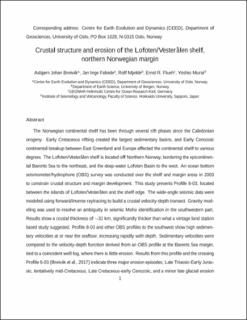| dc.contributor.author | Breivik, Asbjørn Johan | |
| dc.contributor.author | Faleide, Jan Inge | |
| dc.contributor.author | Mjelde, Rolf | |
| dc.contributor.author | Flueh, Ernst | |
| dc.contributor.author | Murai, Yoshio | |
| dc.date.accessioned | 2021-05-20T12:03:03Z | |
| dc.date.available | 2021-05-20T12:03:03Z | |
| dc.date.created | 2020-10-05T16:53:17Z | |
| dc.date.issued | 2020 | |
| dc.Published | Tectonophysics. 2020, 776 . | |
| dc.identifier.issn | 0040-1951 | |
| dc.identifier.uri | https://hdl.handle.net/11250/2755876 | |
| dc.description.abstract | The Norwegian continental shelf has been through several rift phases since the Caledonian orogeny. Early Cretaceous rifting created the largest sedimentary basins, and Early Cenozoic continental breakup between East Greenland and Europe affected the continental shelf to various degrees. The Lofoten/Vesterålen shelf is located off Northern Norway, bordering the epicontinental Barents Sea to the northeast, and the deep-water Lofoten Basin to the west. An ocean bottom seismometer/hydrophone (OBS) survey was conducted over the shelf and margin areas in 2003 to constrain crustal structure and margin development. This study presents Profile 8-03, located between the islands of Lofoten/Vesterålen and the shelf edge. The wide-angle seismic data were modeled using forward/inverse raytracing to build a crustal velocity-depth transect. Gravity modeling was used to resolve an ambiguity in seismic Moho identification in the southwestern part. Results show a crustal thickness of ~31 km, significantly thicker than what a vintage land station based study suggested. Profile 8-03 and other OBS profiles to the southwest show high sedimentary velocities at or near the seafloor, increasing rapidly with depth. Sedimentary velocities were compared to the velocity-depth function derived from an OBS profile at the Barents Sea margin, tied to a coincident well log, where there is little erosion. Results from this profile and the crossing Profile 6-03 (Breivik et al. 2017) indicate three major erosion episodes; Late Triassic-Early Jurassic, tentatively mid-Cretaceous, Late Cretaceous–early Cenozoic, and a minor late glacial erosion episode off Vesterålen. | en_US |
| dc.language.iso | eng | en_US |
| dc.publisher | Elsevier | en_US |
| dc.rights | Attribution-NonCommercial-NoDerivatives 4.0 Internasjonal | * |
| dc.rights.uri | http://creativecommons.org/licenses/by-nc-nd/4.0/deed.no | * |
| dc.title | Crustal structure and erosion of the Lofoten/Vesterålen shelf, northern Norwegian margin | en_US |
| dc.type | Journal article | en_US |
| dc.type | Peer reviewed | en_US |
| dc.description.version | acceptedVersion | en_US |
| dc.rights.holder | Copyright 2020 Elsevier | en_US |
| dc.source.articlenumber | 228318 | en_US |
| cristin.ispublished | true | |
| cristin.fulltext | postprint | |
| cristin.qualitycode | 1 | |
| dc.identifier.doi | 10.1016/j.tecto.2020.228318 | |
| dc.identifier.cristin | 1837291 | |
| dc.source.journal | Tectonophysics | en_US |
| dc.source.40 | 776 | |
| dc.relation.project | European Science Foundation (ESF): CRP01 | en_US |
| dc.identifier.citation | Tectonophysics. 2020, 776, 228318 | en_US |
| dc.source.volume | 776 | en_US |

